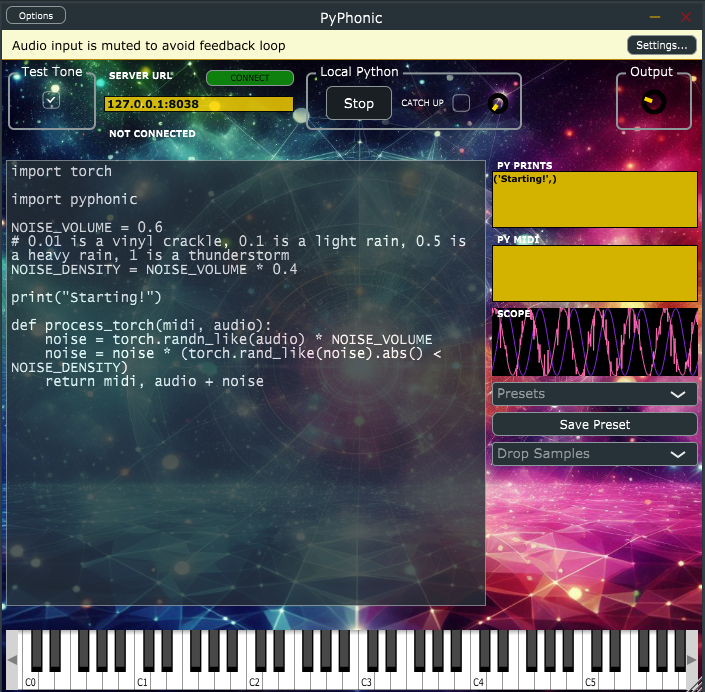This is the Python library for the Pyphonic VST plugin.
Docs: https://audiofluff.github.io/PyPhonic/
The VST streams audio and midi to some server; the server responds with some processed audio.
This library is (one implementation of) the server component.
The VST is not yet released. It's in the final stages of development with release definitely happening in June 2024; you can sign up at https://audiofluff.com to get notified when it's released.
python -c "import pyphonic; from pyphonic.preset_11_polysynth import process; pyphonic.start(process, 8020)"An example using NumPy (recommended over basic Python):
python -c "import pyphonic; from pyphonic.preset_7_sampler import process_npy; pyphonic.start(process_npy, 8020)"An example using PyTorch:
python -c "import pyphonic; from pyphonic.preset_9_saturator import process_torch; pyphonic.start(process_torch, 8020)"
Enter 127.0.0.1:8020 in the VST. Preset 11 sends notes in response to MIDI; preset 7 plays a sample in response to MIDI; preset 9 adds saturation to incoming audio.
import pyphonic
def process(midi, audio):
return midi, audio
PORT = 8020
pyphonic.start(process, PORT)Enter the url http://127.0.0.1:8020 in the VST and voila, you have a perfectly useless plugin.
import pyphonic
def process(midi, audio):
left, right = audio[0], audio[1]
if pyphonic.getBPM() > 140:
return midi, [[x * 1.1 for x in left], [x * 1.1 for x in right]]
return midi, [[0.0 for _ in left], [0.0 for _ in right]]
PORT = 8020
pyphonic.start(process, PORT)import pyphonic
def process_npy(midi, audio):
return [], audio * 0.5
PORT = 8020
pyphonic.start(process_npy, PORT)YMMV with network audio, particularly if you're running this server on a different computer than the VST.
That's why the Pyphonic VST also provides the ability to then take the exact same Python code and run it within the VST. In other words, the remote setup is great for POC and debugging, the next step is to run it in the VST itself. (Optional third step is then to translate the Python code to C++ but that's on you).
Remotely, you can use any third party Python lib installed in your environment (e.g. PyTorch). In the VST, currently, numpy, scipy, torch and librosa (which includes numba and scikit-learn) are offered.
Note: You will need to look at these files to see if they have a process, process_npy or process_torch function and use it accordingly.
pyphonic.preset_4_butterworth- a configurable high/low/bandpass filterpyphonic.preset_5_midiarp- a beat sync'd minor triad MIDI arpeggiatorpyphonic.preset_6_wavetable- a wavetable synth or "ROMpler", demonstrating pitch shiftingpyphonic.preset_7_sampler- a time stretching wavetable synthpyphonic.preset_8_noise- to be charitable, it adds a vinyl crackle or tape hiss to the audiopyphonic.preset_9_saturator- a saturator/distortion effect, nice warmth on EDM drums; also has an electric guitar settingpyphonic.preset_10_fftramp- Ramped FFT-based filtering, interesting effect.pyphonic.preset_11_polysynth- a simple polyphonic sine wave synthpyphonic.preset_12_syncdnoise- beat sync'd noise showing how to get transport info. Can add fizz after a kick.pyphonic.preset_13_sccompressor- fake sidechain compressor, ducking the audio on the kickpyphonic.preset_14_nn_voice_change- uses the SpeechT5 model and HifiGAN vocoder to transform one voice (vocal) to sound like a different speaker. Needs Huggingface and CUDA.pyphonic.preset_15_gen_midi- generates a new MIDI chord every 2 bars with a configurable root note but based on the familiar C, G, Am, F progression. Markovian. DAW must be playing/recording for it to work.pyphonic.preset_16_gen_drums- When DAW is playing, generates a repeating drum pattern. If you're holding C3 the pattern will have a kick, D3 the pattern also has a snare, E3 is closed hat, F3 is open hat, G3 is perc. Change the pattern with (any) midi control change. Must be piped in to a sampler.- (TODO)
pyphonic.reverb- a reverb effect - (TODO)
pyphonic.delay- a beat sync'd delay effect - (TODO)
pyphonic.pitcher- a realtime pitch shift and time stretch effect for audio - (TODO)
pyphonic.deverb- A deep learning model trained to remove reverb - (TODO)
pyphonic.source_separation- A deep learning model trained to separate music into drums, bass, vocals and other
The PyPhonic VST has been released! You can buy it on KVR Audio.
Contributions welcome!
In particular, the VST plugin automatically pulls presets.json and uses that to populate the presets dropdown. If you come up with a great preset and want to share it, please consider making a pull request.
This Python package is licensed under the MIT license. The VST plugin is under separate license.
import json
f = open('my_python_file.py').read()
json.dump(f, open("ready_to_copy_paste_into_presets.json", "w"))
